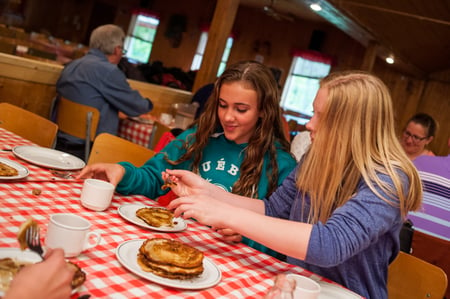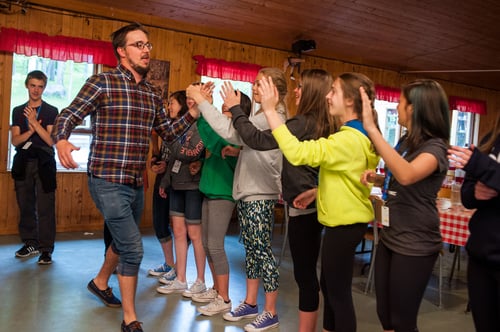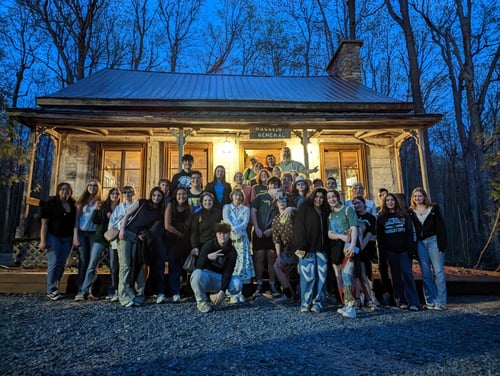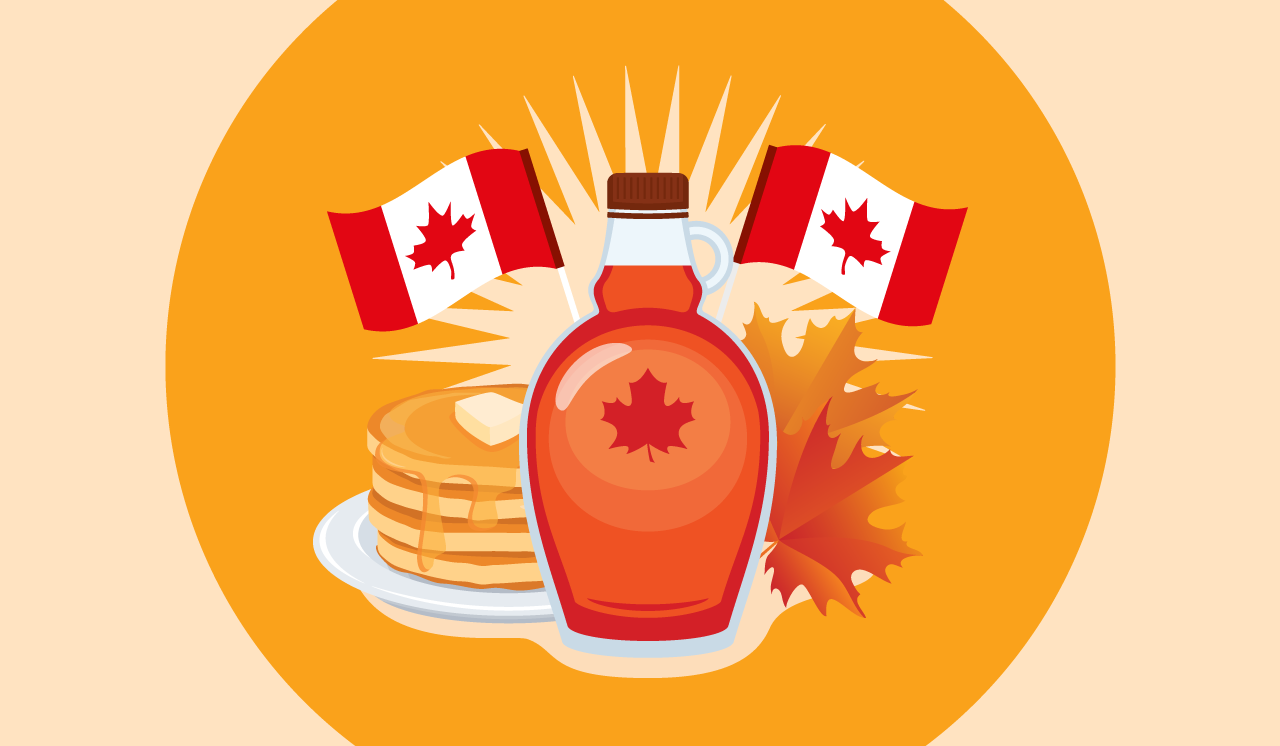As the frost begins to thaw and the first hints of spring emerge, it's time for maple season to kick-off! Across Canada, particularly in the province of Québec, this annual tradition marks the transition from winter to spring. In Québec, this period is referred to as "le temps des sucres," which translates to "the time of the sugars". We like to think of it as the sweetest time of the year!
Originating from the intersection of French settlers and Indigenous practices, maple syrup production and the iconic sugar shacks have become a cornerstone of Québécois culture, cuisine, and identity. Producing about 70% of the world's supply, the maple syrup industry is also a significant economic driver for the province, contributing billions of dollars to the economy each year!
Indigenous Beginnings
The beginnings of maple syrup production trace back centuries to Indigenous practices, long before the arrival of European settlers. Indigenous peoples of the Northeastern Woodlands tribes such as the Algonquin, Iroquois, and Mi'kmaq, were the first to discover the sweet sap of the maple tree and develop methods for extracting and processing it.
They observed that during the early spring thaw, the sap of maple trees began to flow. They discovered it had a slightly sweet taste and could be collected and consumed as a refreshing beverage. Legend says, it was seeing a squirrel bite into the wood of a maple tree to lick the water appearing from the cut, which led the Indigenous to do the same. On behalf of all maple lovers, we would like to take to say, “Thank you, squirrel!”
The techniques and traditions of maple syrup production pioneered by Indigenous peoples were later adopted and adapted by French settlers, who learned from and traded with Indigenous communities. Today, maple syrup production remains deeply rooted in Indigenous knowledge and practices. Many Indigenous-owned and operated maple farms continue the tradition of sugaring off (the processing of maple sap into maple syrup, and then into other products like sugar) while incorporating modern innovations and sustainable practices.
The Science Behind the Sap
Ever wondered how maple syrup is actually made? Sugar in the maple trees is produced through the process of photosynthesis over the summer months and is stored in the tree until it’s ready for harvesting. "Sugaring off", also known as "sugaring season" or "maple sugaring," refers to the process of collecting sap from maple trees and boiling it down to produce maple syrup and other maple products. This occurs typically from late February to early April when temperatures fluctuate between freezing at night and above freezing during the day. These conditions are essential to trigger the sap flow for successful tree tapping and maple syrup production.
During sugaring off, maple trees are tapped by drilling small holes into their trunks and inserting spouts or taps to collect the sap. The sap is then collected either in buckets that are transported to a sugar shack or processing facility, or through an impressive system of tubing that leads directly to the sugar shack evaporator. The sap is then boiled down to remove excess water and concentrate the sugars, resulting in the delicious syrup we all know and love.
The Iconic Sugar Shacks
No exploration of maple syrup season would be complete without a visit to a traditional sugar shack, known as "cabane à sucre" in French. Dating back to the 17th century, these cabins were simple structures built in the woods to house sugaring operations during maple syrup season. Today, these rustic yet charming establishments offer a glimpse into the province's rich cultural heritage, giving visitors a taste of French-Canadian hospitality, cuisine, music, and more.
Visitors can indulge in a feast of maple-infused delicacies, from fluffy pancakes to savoury pea soup. And don't worry if you don't taste enough maple—there will be jugs of maple syrup placed on every table, ready (and strongly encouraged) for you to pour on top of everything! The sugar shack experience also features live traditional music and dancing. If you’re headed to one, join the fun by learning traditional folk dances like the square dance or jig. Follow your Tour Director’s lead for all the best moves to dance off your sugar high.
Another beloved tradition in Québec's sugar shacks is the making of "tire d'érable sur la neige," or maple taffy on snow. Maple syrup that has been brought to a boil to concentrate the sugars is poured directly onto packed snow, then rolled up on a wooden stick to create a deliciously sweet treat—a true Canadian delicacy.
Syrup and Beyond
Maple syrup is a key ingredient in many traditional French-Canadian dishes, including maple-glazed ham, sugar pie (tarte au sucre), and tourtière (meat pie). The sweet, rich flavour of maple syrup adds depth and complexity to these dishes, distinguishing them as quintessential Québécois fare.
While maple syrup is the most famous maple product, Québec also produces a wide range of other maple-infused delicacies, including maple butter, maple sugar candies, maple vinegar, and iconic maple cookies. Learn more about the traditional French-Canadian Sugar Shack Meal, and what's it al about, in this blog.
Not just a sweet treat, maple has many health benefits as well as environmental benefits. And here we thought we couldn't love maple any more!
The Maple Market & Mafia—It’s Big Business!
Maple syrup is not just a delicious delight—it’s serious business as an in-demand, hot commodity. Did you know there's a governing body that regulates all maple production in Québec, The Federation of Québec Maple Syrup Producers (FPAQ)? Formed in 1966, the FPAQ regulates the quality, price, and supply of the province’s maple in order to stabilize the market. Nestled in Laurierville, Québec, their central production and storage facility keeps the syrup industry in check.
The FPAQ has such influence and control over a significant amount of the global maple syrup supply that they’re referred to as the "syrup cartel” or “maple mafia”. But don't be fooled by the term "cartel"— the FPAQ operates legally and even cracks down on bootleggers and black-market syrup sales. However, the FPAQ's activities are highly controversial among maple producers, especially smaller ones, who argue that they artificially inflate prices and limit competition.
If you’re curious to see what goes on behind the scenes, you can take a tour through the high-security Global Strategic Maple Syrup Reserve here.
The Great Canadian Maple Syrup Heist
In 2012, Québec made headlines when thieves stole over 6 million pounds of maple syrup worth an estimated $18 million dollars from a strategic reserve. Dubbed the "Great Canadian Maple Syrup Heist", it was one of the most bizarre and audacious thefts in Canadian history.
The heist occurred in a remote warehouse located in Saint-Louis-de-Blandford, Québec, where the FPAQ stored its reserve maple syrup. In the wake of the discovery, authorities launched a sprawling investigation to uncover the truth behind the robbery. What they uncovered was a sophisticated smuggling operation involving numerous individuals, from syrup producers to warehouse workers and truckers.
The Great Maple Syrup Heist left an indelible mark on Canada's maple syrup industry, sparking international intrigue and captivating the public's imagination. It underscored the value and significance of maple syrup as a high-value commodity and highlighted the challenges of regulating and protecting such a sought-after resource.
Maple-themed Festivals
 Maple Season is so celebrated and highly anticipated each year that there are festivals dedicated to the sweet Canadian staple! The festival Cabane Panache takes place in Montréal’s vibrant rue Wellington in the neigbourhood of Verdun, which was named coolest street in the world by Time Out magazine in 2022. The annual event celebrates Québec’s rich cultural heritage and the arrival of spring. The festival transforms the streets into a lively outdoor fairground, where visitors can indulge in a mouthwatering array of maple-infused dishes, from classic sugar shack fare, like pancakes and pea soup, to creative culinary creations crafted by local chefs. From axe throwing and log sawing competitions to maple taffy on snow, there are tons of activities to entertain visitors and celebrate the roots of maple syrup in Canadian culture.
Maple Season is so celebrated and highly anticipated each year that there are festivals dedicated to the sweet Canadian staple! The festival Cabane Panache takes place in Montréal’s vibrant rue Wellington in the neigbourhood of Verdun, which was named coolest street in the world by Time Out magazine in 2022. The annual event celebrates Québec’s rich cultural heritage and the arrival of spring. The festival transforms the streets into a lively outdoor fairground, where visitors can indulge in a mouthwatering array of maple-infused dishes, from classic sugar shack fare, like pancakes and pea soup, to creative culinary creations crafted by local chefs. From axe throwing and log sawing competitions to maple taffy on snow, there are tons of activities to entertain visitors and celebrate the roots of maple syrup in Canadian culture.
Plessisville, located in the Chaudière-Appalaches region of Québec, is the proud host of the Festival Beauceron de l'Érable. This festival spans several days in May and celebrates all things maple in a picturesque setting surrounded by maple forests and sugar shacks. The festival offers an authentic Québécois experience, celebrating the sights, sounds, and flavours of Québec's maple heritage off the beaten path. There are also a wide range of activities like maple tastings and workshops, interactive exhibits, and culinary competitions where chefs use creativity and skill to incorporate maple syrup into innovative dishes.
Experience Sugar Shacks for Yourself!
Ask any student, teacher, or Tour Director what the best part of their trip to Québec was. We’re placing our bets on that maple-filled evening at the sugar shack!
Taking your students to visit a traditional sugar shack offers a perfect blend of fun and education, providing a unique opportunity to explore Canada's natural beauty and cultural heritage. Students can see firsthand the intricate network of tubes and taps that channel sap from tree to sugar shack. They'll gain insight into the environmental factors that influence sap flow, the role of photosynthesis, and the chemistry behind sap's transformation into delicious maple syrup. Students will end their experience on a (sugar) high note with the sugar shack visit on the last night of their trip, rounding out their tour with a celebration they’ll never forget.
You can enjoy an authentic sugar shack experience on a Jumpstreet tour when you visit Québec City, Ottawa or Montréal. We also have a maple tasting experience in Niagara Falls that’s sure to please the taste buds! Speak with your Tour Consultant to start planning today.
Heading to Montréal? Learn more about sugaring season, the fascinating history behind sugar shacks, and most importantly, the must-have maple treats to try while you’re visiting in this blog. Looking for more information? Head to the Jumpstreet Sugar Shack for extra teacher resources!



